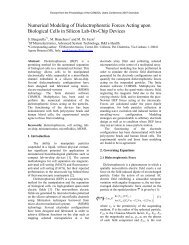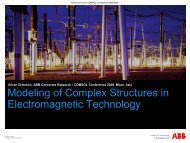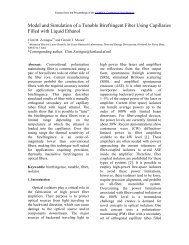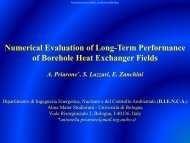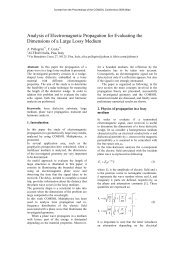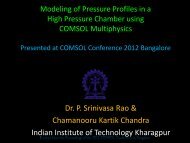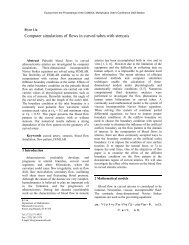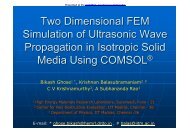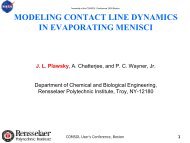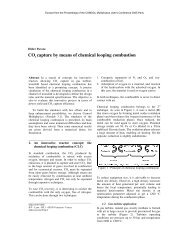Hydro-Mechanical Modeling of a Shaft Seal in a ... - COMSOL.com
Hydro-Mechanical Modeling of a Shaft Seal in a ... - COMSOL.com
Hydro-Mechanical Modeling of a Shaft Seal in a ... - COMSOL.com
Create successful ePaper yourself
Turn your PDF publications into a flip-book with our unique Google optimized e-Paper software.
Presented at the <strong>COMSOL</strong> Conference 2010 Boston<br />
<strong>Hydro</strong>-<strong>Mechanical</strong> <strong>Model<strong>in</strong>g</strong> <strong>of</strong><br />
a <strong>Shaft</strong> <strong>Seal</strong> <strong>in</strong><br />
a Deep Geological Repository<br />
D. G. Priyanto<br />
Presented at<br />
<strong>COMSOL</strong> Conference 2010<br />
Boston, 2010 October 7-9<br />
UNRESTRICTED / ILLIMITÉ
Background<br />
• The Nuclear Waste Management Organization’s (NWMO) Adaptive<br />
Phased Management (APM) approach to nuclear fuel waste<br />
management <strong>in</strong>cludes the isolation and conta<strong>in</strong>ment <strong>of</strong> used nuclear<br />
fuel <strong>in</strong> a Deep Geological Repository (DGR).<br />
• A shaft seal is one <strong>of</strong> the eng<strong>in</strong>eered barriers considered <strong>in</strong> isolat<strong>in</strong>g<br />
and conta<strong>in</strong><strong>in</strong>g used nuclear fuel <strong>in</strong> a Deep Geological Repository<br />
(DGR).<br />
UNRESTRICTED / ILLIMITÉ<br />
2
<strong>Shaft</strong> <strong>Seal</strong><strong>in</strong>g Concept<br />
<strong>Shaft</strong> <strong>Seal</strong><strong>in</strong>g Concept<br />
AECL @1993<br />
<strong>Shaft</strong> <strong>Seal</strong><br />
A shaft seal<br />
•would be <strong>in</strong>stalled at strategic<br />
locations, such as significant<br />
fracture zone.<br />
Deep Geological Repository (DGR)<br />
•to limit the potential for fast<br />
movement <strong>of</strong> groundwater from<br />
repository level to the surface<br />
via the shaft.<br />
<strong>Shaft</strong> <strong>Seal</strong><strong>in</strong>g Concept<br />
AECL @ 1993<br />
UNRESTRICTED / ILLIMITÉ<br />
3
Full-Scale <strong>Shaft</strong> <strong>Seal</strong> at AECL’s URL<br />
(Dixon, Mart<strong>in</strong>o & Onagi 2009)<br />
The objective <strong>of</strong> the seals at URL is to<br />
limit the mix<strong>in</strong>g <strong>of</strong> groundwater with<br />
higher sal<strong>in</strong>ity below the FZ with<br />
lower sal<strong>in</strong>ity above the FZ.<br />
•The seal construction is funded by<br />
Natural Resources Canada (NRCan)<br />
under the Nuclear Legacies Liability<br />
Program (NLLP).<br />
•Monitor<strong>in</strong>g is funded by Enhanced<br />
<strong>Seal</strong><strong>in</strong>g Project (ESP) (NWMO,<br />
Posiva Oy, SKB and ANDRA).<br />
<strong>Seal</strong>s at the AECL’s Underground Research<br />
Laboratory (Mart<strong>in</strong>o et al. 2010)<br />
• THM responses be<strong>in</strong>g monitored<br />
<strong>in</strong>clude: temperatures, displacements,<br />
stra<strong>in</strong>s, pore pressures, & total<br />
pressures at selected location.<br />
UNRESTRICTED / ILLIMITÉ<br />
4
Objective<br />
The objective <strong>of</strong> this presentation is:<br />
• to evaluate the capability <strong>of</strong> <strong>COMSOL</strong> to simulate the hydraulic<br />
& mechanical (H-M) processes <strong>of</strong> a shaft seal <strong>in</strong>stalled at a<br />
fracture zone <strong>in</strong> a hypothetical geosphere.<br />
The f<strong>in</strong>al objective:<br />
• to simulate all required processes <strong>of</strong> an actual shaft seal.<br />
(e.g., coupl<strong>in</strong>g H, M, T, Mass transfer)<br />
UNRESTRICTED / ILLIMITÉ<br />
5
Hypothetical <strong>Shaft</strong> <strong>Seal</strong> Geometry<br />
2D-axisymetrical geometry<br />
CL<br />
100 m<br />
Hydraulic Properties <strong>of</strong> the<br />
Geosphere<br />
B<br />
100 m<br />
K FZ-Center = 10 -9 m/s<br />
C<br />
3 m<br />
K FZ-Side = 10 -10 m/s<br />
K rocks<br />
D<br />
E<br />
1 m<br />
A<br />
C<br />
B<br />
6 m<br />
3 m<br />
100 m<br />
4 m 2 m<br />
<strong>Shaft</strong><br />
Elevations<br />
(250 m)<br />
Legend<br />
A : Bentonite-Sand Mixture (BSM)<br />
B : Dense Backfill (DBF)<br />
C : Concrete<br />
D : Fractured Zone (FZ)<br />
E : Crystall<strong>in</strong>e Rocks<br />
7.3 m<br />
A, B, and C are <strong>in</strong><br />
unsaturated conditions at <strong>in</strong>stallation<br />
UNRESTRICTED / ILLIMITÉ<br />
6
Stages <strong>of</strong> Numerical <strong>Model<strong>in</strong>g</strong><br />
1. Stage 1 simulates groundwater flow <strong>in</strong>to open shaft and stress condition<br />
prior to seal <strong>in</strong>stallation.<br />
Duration: time between excavation and shaft seal <strong>in</strong>stallation (100 y)<br />
2. Stage 2 simulates groundwater flow after shaft seal <strong>in</strong>stallation.<br />
Duration: depend<strong>in</strong>g the half life <strong>of</strong> the nuclear waste (0 – 1,000,000 y)<br />
Stage 1 Stage 2<br />
DBF<br />
Open shaft<br />
C<br />
100 y<br />
CS<br />
C<br />
BSM<br />
CS<br />
0-1,000,000 y<br />
DBF<br />
UNRESTRICTED / ILLIMITÉ<br />
7
Challenges<br />
Challenge 1<br />
• <strong>Seal</strong><strong>in</strong>g <strong>com</strong>ponents are <strong>in</strong>itially unsaturated,<br />
• Clay-based seal<strong>in</strong>g <strong>com</strong>ponents have large volume change<br />
coupl<strong>in</strong>g <strong>of</strong> the unsaturated flow with structural mechanics<br />
Challenge 2<br />
• Properties and conditions at the seal location change abruptly<br />
between Stages 1 and 2.<br />
Challenge 3<br />
• The durations <strong>of</strong> Stages 1 and 2 considered <strong>in</strong> this study are<br />
anticipated to be <strong>in</strong> order <strong>of</strong> 100 years to 1,000, 000 years.<br />
reasonable solution time<br />
UNRESTRICTED / ILLIMITÉ<br />
8
Coupl<strong>in</strong>g <strong>of</strong> HM Formulation for<br />
Unsaturated Soil<br />
Detailed formulations are provided <strong>in</strong><br />
(Priyanto 2010)<br />
H<br />
p<br />
C<br />
SeS <br />
KH<br />
p<br />
D Qs<br />
S<br />
t<br />
S = f g ( p + f )<br />
k<br />
e<br />
sat<br />
w<br />
k<br />
0<br />
<br />
<br />
3<br />
1 <br />
1<br />
<br />
<br />
1<br />
H<br />
<br />
<br />
<br />
<br />
1<br />
m<br />
<br />
C 1<br />
m<br />
<br />
<br />
0<br />
<br />
<br />
s<br />
<br />
p<br />
<br />
2<br />
n<br />
<br />
<br />
1 <br />
<br />
<br />
<br />
m<br />
K <br />
<br />
2<br />
0<br />
3<br />
0<br />
for<br />
for<br />
<br />
1<br />
S<br />
<br />
UNRESTRICTED / ILLIMITÉ<br />
r<br />
S<br />
e<br />
1<br />
m<br />
k sat<br />
k<br />
w r<br />
H<br />
e<br />
H<br />
1<br />
m<br />
p<br />
p<br />
<br />
<br />
<br />
0<br />
0<br />
m<br />
for<br />
for<br />
H<br />
H<br />
p<br />
p<br />
0<br />
0<br />
100 mm<br />
•Unsaturated flow = Richard’s equation<br />
with vanGenuchten’s SWCC and<br />
permeability models.<br />
•<strong>Mechanical</strong> = L<strong>in</strong>ear elastic model<br />
•Compare with laboratory triaxial test <strong>of</strong><br />
CL<br />
the Bentonite-Sand CL<br />
Impermeable Mixture (BSM)<br />
CL<br />
50 mm<br />
y<br />
Triaxial Specimen<br />
(a)<br />
50 mm<br />
x<br />
Symmetry<br />
Symmetry<br />
l<strong>in</strong>e<br />
CL<br />
y<br />
Impermeable<br />
Symmetry<br />
u w = 0.2 MPa<br />
x<br />
Symmetry<br />
No flow<br />
at symmetry Impermeable l<strong>in</strong>e<br />
Initial<br />
u w = 0.2 MPa<br />
u a = 0.101 MPa<br />
w c = 18.75%<br />
(b)<br />
Hydraulic<br />
Impermeable<br />
Initial<br />
u a = 0.101 MPa<br />
w c = 18.75%<br />
CL<br />
y<br />
Initial<br />
p = 0.5 MPa<br />
Symmetry<br />
No y-displacement<br />
at symmetry l<strong>in</strong>e<br />
Initial<br />
p = 0.5 MPa<br />
Symmetry<br />
x<br />
(c)<br />
<strong>Mechanical</strong><br />
9
Results <strong>of</strong> HM Numerical <strong>Model<strong>in</strong>g</strong><br />
<strong>of</strong> Unsaturated BSM Specimen<br />
Dry density<br />
CL<br />
Impermeable<br />
CL<br />
X = 0 cm<br />
100 mm<br />
CL<br />
50 mm<br />
y<br />
Triaxial Specimen<br />
(a)<br />
50 mm<br />
x<br />
Symmetry<br />
Symmetry<br />
l<strong>in</strong>e<br />
CL<br />
y<br />
Impermeable<br />
Symmetry<br />
u w = 0.2 MPa<br />
No flow<br />
at symmetry Impermeable l<strong>in</strong>e<br />
Initial<br />
u w = 0.2 MPa<br />
u a = 0.101 MPa<br />
w c = 18.75%<br />
(b)<br />
x<br />
Impermeable<br />
Initial<br />
u a = 0.101 MPa<br />
w c = 18.75%<br />
CL<br />
y<br />
Initial<br />
p = 0.5 MPa<br />
X = 0.5 cm<br />
X = 1.0 cm<br />
X = 1.5 cm<br />
X = 2.0 cm<br />
X = 2.5 cm<br />
Symmetry<br />
Symmetry<br />
Degree <strong>of</strong> saturation<br />
Symmetry<br />
No y-displacement<br />
at symmetry l<strong>in</strong>e<br />
Initial<br />
p = 0.5 MPa<br />
(c)<br />
x<br />
X = 0 cm<br />
X = 0.5 cm<br />
X = 1.0 cm<br />
X = 1.5 cm<br />
X = 2.0 cm<br />
Volume <strong>of</strong> Water Added (mL)<br />
18<br />
16<br />
14<br />
12<br />
10<br />
8<br />
6<br />
4<br />
2<br />
0<br />
Volume <strong>of</strong> water added<br />
to the specimen<br />
Laboratory Test<br />
<strong>COMSOL</strong><br />
0 2 4 6 8 10<br />
Time (days)<br />
X = 2.5 cm<br />
UNRESTRICTED / ILLIMITÉ<br />
10
H-M <strong>Model<strong>in</strong>g</strong> <strong>of</strong> <strong>Shaft</strong> <strong>Seal</strong><br />
CL<br />
100 m<br />
Hydraulic Properties <strong>of</strong> the<br />
Geosphere<br />
B<br />
100 m<br />
K FZ-Center = 10 -9 m/s<br />
C<br />
3 m<br />
K FZ-Side = 10 -10 m/s<br />
K rocks<br />
D<br />
E<br />
1 m<br />
A<br />
C<br />
B<br />
6 m<br />
3 m<br />
100 m<br />
4 m 2 m<br />
<strong>Shaft</strong><br />
Elevations<br />
(250 m)<br />
Legend<br />
A : Bentonite-Sand Mixture (BSM)<br />
B : Dense Backfill (DBF)<br />
C : Concrete<br />
D : Fractured Zone (FZ)<br />
E : Crystall<strong>in</strong>e Rocks<br />
7.3 m<br />
UNRESTRICTED / ILLIMITÉ<br />
11
Porewater Pressure, Stage 1<br />
Stage 1, groundwater flow <strong>in</strong>to open shaft<br />
0 1 10 100<br />
[Years]<br />
Note that this results is only valid for the hypothetical assumptions<br />
and properties used <strong>in</strong> this study.<br />
UNRESTRICTED / ILLIMITÉ<br />
12
Porewater Pressure, Stage 2<br />
(0-100 years)<br />
Stage 2, groundwater flow <strong>in</strong>to shaft seal<br />
0 1 10 80 100<br />
[Years]<br />
Note that this results is only valid for the hypothetical assumptions<br />
and properties used <strong>in</strong> this study.<br />
UNRESTRICTED / ILLIMITÉ<br />
13
Porewater Pressure, Stage 2<br />
(1e3-1e6 years)<br />
Stage 2, groundwater flow <strong>in</strong>to shaft seal<br />
1,000 10,000 100,000 1,000,000<br />
[Years]<br />
Note that this results is only valid for the hypothetical assumptions<br />
and properties used <strong>in</strong> this study.<br />
UNRESTRICTED / ILLIMITÉ<br />
14
Porewater Pressure, Stage 2<br />
Stage 2, groundwater flow <strong>in</strong>to shaft seal<br />
0 1 10 20 40<br />
Note that this results is only valid for the hypothetical<br />
assumptions and properties used <strong>in</strong> this study.<br />
60 80 90 100 1,000<br />
[Years]<br />
UNRESTRICTED / ILLIMITÉ<br />
15
Saturation Degree and Dry Density<br />
<strong>of</strong> the BSM<br />
DBF<br />
CS<br />
C<br />
BSM<br />
r<br />
CS<br />
DBF<br />
Time (Years)<br />
1E-03 1E-02 1E-01 1E+00 1E+01 1E+02 1E+03<br />
2.2<br />
2.1<br />
2.0<br />
1.9<br />
1.8<br />
1.7<br />
1.6<br />
1.5<br />
Dry Density [Mg/m 3 ]<br />
Case 5:<br />
MFR<br />
r = 0<br />
r = 1 m<br />
r = 2 m<br />
r = 3 m<br />
r = 3.65 m<br />
Note that this results is only valid for the hypothetical assumptions<br />
and properties used <strong>in</strong> this study.<br />
Time (Years)<br />
1E-03 1E-02 1E-01 1E+00 1E+01 1E+02 1E+03<br />
100<br />
95<br />
90<br />
85<br />
80<br />
75<br />
70<br />
65<br />
60<br />
Degree <strong>of</strong> Saturation [%]<br />
Case 5:<br />
MFR<br />
r = 0<br />
r = 1 m<br />
r = 2 m<br />
r = 3 m<br />
r = 3.65 m<br />
UNRESTRICTED / ILLIMITÉ<br />
16
Conclusions<br />
• This study has developed custom-additions <strong>in</strong> <strong>COMSOL</strong><br />
– to couple Richard’s equation and l<strong>in</strong>ear elastic model<br />
– to implement a custom SWCC and permeability model observed from<br />
the results <strong>of</strong> laboratory test<strong>in</strong>g <strong>of</strong> the bentonite-sand mixture<br />
specimens.<br />
• The results <strong>of</strong> the numerical model<strong>in</strong>g <strong>of</strong> a shaft seal us<strong>in</strong>g <strong>COMSOL</strong> shows<br />
a logical hydraulic and mechanical processes, which <strong>in</strong>dicated that<br />
<strong>COMSOL</strong> can be used as a tool for further study <strong>of</strong> a shaft seal <strong>in</strong> a deep<br />
geological repository.<br />
• Us<strong>in</strong>g current <strong>com</strong>puter capability, the solution time required to <strong>com</strong>plete the<br />
analysis to simulate 1000000 years HM behavior <strong>of</strong> a shaft seal described <strong>in</strong><br />
this study was less than 1 hour, which is beneficial <strong>in</strong> build<strong>in</strong>g more <strong>com</strong>plex<br />
model and formulations to simulate an actual shaft seal <strong>in</strong> actual geosphere<br />
conditions.<br />
UNRESTRICTED / ILLIMITÉ<br />
17
Re<strong>com</strong>mendations<br />
• Future studies re<strong>com</strong>mended to improve simulation <strong>of</strong> a shaft seal<br />
<strong>in</strong>cludes:<br />
– Development <strong>of</strong> coupl<strong>in</strong>g formulation <strong>of</strong> multi-phase flow with<br />
mechanical constitutive model to improve HM simulation.<br />
– Coupl<strong>in</strong>g between HM processes with other processes such as<br />
thermal and mass transport.<br />
– Implementation <strong>of</strong> elasto-plastic model.<br />
UNRESTRICTED / ILLIMITÉ<br />
18
Thank you !<br />
Acknowledgements<br />
<strong>Hydro</strong>-<strong>Mechanical</strong> <strong>Model<strong>in</strong>g</strong> <strong>of</strong> a <strong>Shaft</strong> <strong>Seal</strong> <strong>in</strong> a Deep Geological Repository<br />
Atomic Energy <strong>of</strong> Canada Limited (AECL)<br />
D. G. Priyanto<br />
Nuclear Waste Management Organization (NWMO)<br />
<strong>COMSOL</strong> Conference 2010<br />
Boston, 2010 October 7-9<br />
AECL personnel, especially:<br />
David Dixon, Paul Thompson, Peter Sargent,<br />
Chang-Seok Kim, Blake Holowick,<br />
Maureen MacDonald & Marlene Hall.<br />
UNRESTRICTED<br />
AECL - OFFICIAL<br />
/ ILLIMITÉ<br />
USE ONLY / À USAGE EXCLUSIF - EACL 19


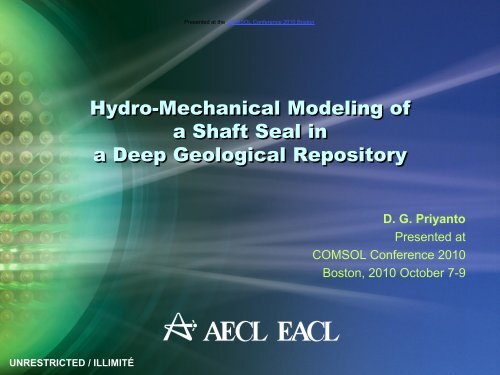
![[PDF] Microsoft Word - paper.docx - COMSOL.com](https://img.yumpu.com/50367802/1/184x260/pdf-microsoft-word-paperdocx-comsolcom.jpg?quality=85)
